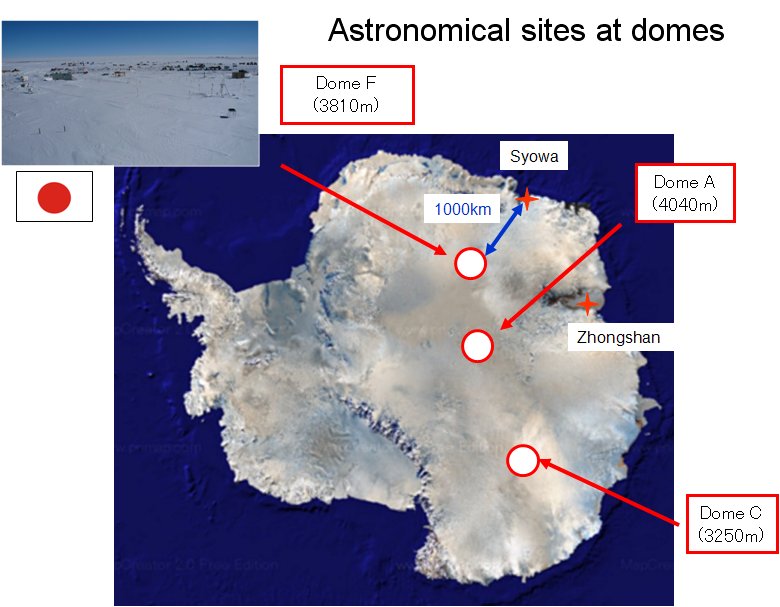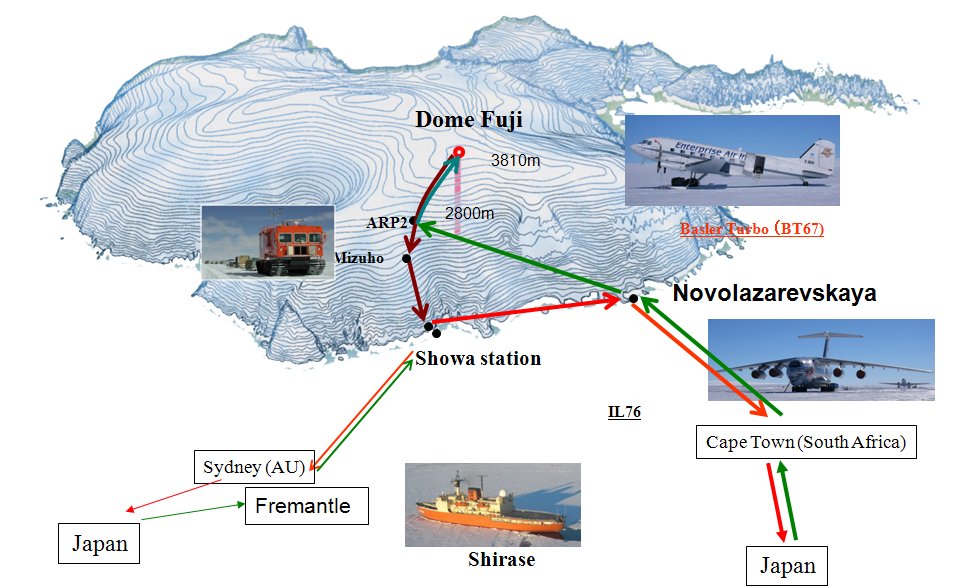

Astronomy at Dome Fuji in Antarctica
Antarctica is expected to be the last window open to space for ground-based astronomical observations. Especially, the highest regions of the Antarctic plateau above 3,000 m elevation are an attractive environment for observational astronomy. Due to low temperature, thermal noise at infra-red wavelengths is much lower in Antarctica than other temperate sites. Dry atmosphere with little water vapor is more transparent in infra-red to sub-millimeter. At the summits of the plateau the wind speed is low and the atmosphere is stable, so that no violent storms and blizzards exist. Since the surface inversion layer is thin, we expect good seeing. As better sites than South Pole there are several bases on the summits of the plateau, Dome C, Dome A, and Dome Fuji (also known as Dome F) (Fig.1). Astronomers in the world pay attention to these sites with good conditions. In that context, Japanese group has organized a consortium consisting of four universities (Tohoku, Tsukuba, Rikkyo, Nagoya) and two institutes, (National Institute of Polar Research and National Astronomical Observatory) to promote the astronomy in Dome Fuji.
Domue Fuji
Dome Fuji station is located at -77^o 19' 01''S, 39^o 42' 12''E; 1000 km inland on the Antarctic Continent at 3810 m above sea level, which is the second-highest summit of the Antarctic ice sheet. It was established in 1995 by NIPR for the deep drilling program and atmospheric observations. The year-round average temperature is about -54^oC, and in winter the temperature comes down to as low as -80^oC. Due to this low temperature, thermal noise at infra-red wavelengths is much lower in Antarctica than other sites. Although the site is on the border of the aurora oval, it is not a drawback for infrared and THz astronomy. In 2006 we carried out monitoring observations of the atmospheric turbulence in the boundary layer (up to the altitude of 1000 m) by SODAR and the transparency by a 220 GHz radio meter in summer. However, it is in the winter season that the superior characteristic of the Antarctica appears, so that it is necessary for us to examine turbulence and transparency in the winter.
Science goals
To enjoy the advantages in Antarctica, we are planning to construct 2m-class infrared and 10m-class THz telescopes. Thanks to low background and high transmittance, a 2m-class telescope has a capability of 8m-class telescopes located at Mounakea in near-/mid-infrared. An infrared survey observation in K-dark band at 2.4 micron will give the deepest and widest dataset for the high-z universe with reasonable cost and observation time. It will reach deeper than those of VISTA and UKIDSS by 1-2 mag. The THz telescope will target dusty galaxies at the high-z universe to study galaxy evolution in its early phase of star formation enshrouded in dust. The long polar night in winter is favorable for searching variable objects with a long period such like extra-solar planets in orbit of habitable zone. The observation with molecules (e.g., CO, H_2O, CH_4) at the second eclipse will give us the information of the atmosphere. To do such observations we are making near-/mid-infrared instruments for imaging and spectroscopy.
Future plan
NIPR has planned the construction of a new permanent winter-over station with raised floors at Dome Fuji in the next 6-year program, because the old station was buried under snow. Astronomical facilities are also expected. Before the completion of the station, we will start astronomical site testing and pilot research (e.g., CO survey in Galactic plane, faint stellar halo of nearby galaxies, second eclipse of exoplanets) with small telescopes and site-testing equipments from 2010. In collaboration with Australian group (Storey et al.), we will construct PLATO for Dome Fuji, which will enable us to make unmanned operation of the instruments before the winterover station is constructed. (Please find current status in the reports below).
40cm Infrared telescope at Dome Fuji
Report
2016/06/26 SPIE (Edinburgh, UK)
"An optical design of the wide-field imaging and multi-object spectrograph for an Antarctic infrared telescope"
2013/06/24 Medium-Size Telescope Science Workshop East Asian Core Observatories Association (EACOA) (Kunming, China)
"Dome Fuji: Antarctic Infrared Telescope and its Science Drivers"
2010/8/3 SCAR
"Infrared Astronomy in Antarctica"
2009/8/6 IAU General Assembly, Special Session
"Astronomy at Dome Fuji in Antarctica"